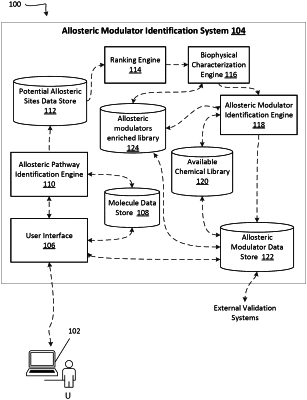| CPC G16C 20/62 (2019.02) [G16C 20/10 (2019.02); G16C 20/30 (2019.02); G16C 20/64 (2019.02)] | 18 Claims |

|
1. A system for designing chemical libraries for allosteric modulator discovery, the system comprising:
at least one processing device; and
at least one memory device in communication with the processing device, the memory device comprising instructions that, when executed by the processing device, cause the system to perform the following operations for each of a plurality of protein targets:
(a) identifying a plurality of allosteric sites for the protein target by analyzing biophysical and dynamics data for each protein to discover sites located on surfaces of each protein that are energetically coupled to a site of designated activity through an energy transfer network of residues within each protein, wherein the biophysical and dynamics data is obtained by one or more of NMR, X-ray crystallography, Cryo-EM, neutron scattering, hydrogen-deuterium exchange, and computer simulations;
(b) characterizing structural and electrostatic properties of the identified allosteric sites;
(c) computationally screening fragment libraries to identify a set of one or more fragments and small molecules that have structural and electrostatic properties that fit well for binding to the allosteric sites;
(d) creating a list of chemical compounds based on the set of one or more fragments and small molecules and the structural and electrostatic properties of the identified allosteric sites;
(e) combining different fragments and small molecules from the list to design a plurality of optimized compounds;
(f) characterizing the optimized compounds based on suitability as allosteric modulators of the protein target;
(g) saving information regarding the optimized compounds to a chemical library data store; and
(h) repeating steps (a)-(g) until the chemical library achieves a desired level of enrichment of optimized compounds.
|